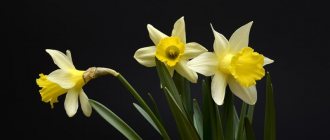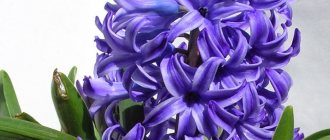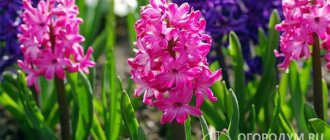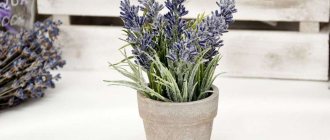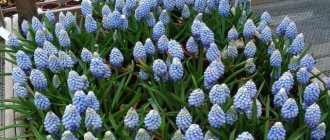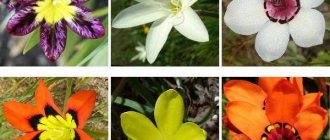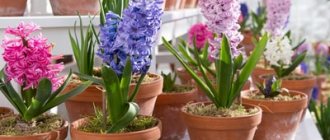Hyacinth is a bulbous plant with bright and fragrant flowering in early spring.
The flower is unique in that it can be successfully grown both in open ground and as an indoor flower that can be made to bloom at a certain time. Familiarity with the characteristics of a flower's growing season will help you learn how to grow at home and how to care for a plant.
Types of hyacinth
The genus Giacint unites only 3 species:
- hyacinth Oriental;
- hyacinth Litvinova;
- hyacinth Transcaspian.
In decorative floriculture, only Eastern hyacinth , characterized by:
- a dense, fleshy bulb, the color of the upper layer of scales of which, in its basic tone, correlates with the shade of the petals ;
- rosette leaves of linear or elongated oval shape with a pointed apex ;
- an erect peduncle rising to a height of up to 30 cm and bearing a racemose fragrant inflorescence formed by flowers with dense bell-shaped corollas.
Popular varieties for indoor growing
Based on Eastern hyacinth, numerous hybrids , the descriptions of which differ:
- structure of the corollas: simple and terry ;
- petal color: white, yellow, orange, blue and purple, pink, red and black;
- Flowering dates: early, mid and late blooming.
Oriental hyacinth hybrids are unusually decorative; the Internet is replete with numerous photos of them. Most are suitable for growing indoors . The most common varieties found at home are:
- Ostara, with high (up to 30 cm) peduncles and loose purple inflorescences about 13 cm long, maintaining freshness for 3 weeks.
- Rosalia, different pink shades of inflorescences, consisting of 15-17 small (diameter 2 cm) buds with a short flowering period.
- Sunflower, with peduncles up to 20 cm high and medium-density cream inflorescences formed by small (3.5 cm) double flowers. Blooms for 2 weeks.
- Amethystcharacterized by a light purple color dense inflorescences up to 10 cm long and a one-week flowering period.
- La Victoire, which have gained popularity thanks to their dense inflorescences of spectacular bright red tones.
Features of a flowering plant
Hyacinth is one of the first spring flowers. Early varieties bloom in open ground from mid-March , middle varieties - from April, and late varieties bloom in May.
Flowering period is from one to two weeks. At home, the sequence of the plant’s biorhythms is maintained. However, using the forcing method, you can achieve flowering by a certain date - Christmas, March 8th.
Maintaining the temperature at 15-16oC increases the duration of hyacinth flowering from 2 to 4 weeks.
Why doesn't it bloom and how to fix it?
Sometimes it happens that a plant in a pot does not bloom , despite all the efforts made. The reasons for the lack of flowering and ways to solve the problem are indicated in the table.
| Why doesn't it bloom in a pot?? | What to do? |
| The optimal flowering temperature is 16-18oC. If the room is too hot, flowering may not occur or may end very quickly. | Take the pot out to a glassed-in loggia, balcony, terrace during the day |
| The absence of a drainage layer of sand or other material leads to rotting of the onion | If the bulb is not dead, cut off the damaged parts, treat with fungicide, sprinkle with coal and repeat the planting cycle again. A positive result is not guaranteed |
| The plant lacks sun and minerals | Move to the sun and fertilize |
| Poor quality bulbs (old, spoiled, diseased). | Change planting material |
Hyacinth is a demanding flower to care for. Even a slight deviation from the correct growing technology threatens a decrease in flowering properties and the death of the entire plant.
For a plant in open ground, there are some nuances as to why there are no flowers. What happened and how to correct the matter is shown in the table.
| Why doesn't it bloom outside?? | What to do? |
| The bulbs were not dug up in the summer | Dig up and store bulbs annually |
| Plants were planted in open ground too early or late | The best time for planting in the soil is the last days of September, the beginning of October |
| Flowers were planted without a sand layer, water stagnates in the beds | Be sure to add a 3-5 cm layer of river sand before planting. |
| The soil is acidic, dense, clayey | Carry out measures to neutralize and loosen the soil |
| Fresh manure was applied to the planting area | Use only well-rotted humus and mineral fertilizers |
| Lots of weeds, especially weeds | Thorough regular weeding |
| Planted flowers in a place affected by diseases from previous crops | Do not plant hyacinths in areas previously occupied by other bulbs, potatoes, and tomatoes. |
If in the spring the hyacinths did not even produce leaves, then the “non-working” bulbs are probably affected by pests. They need to be dug up and burned. Plant new flowers in another place.
Pests and infections
Pests:
- the larvae of flower flies gnaw the bottom and scales of the bulbs, the plant withers and dies;
- aphids and thrips suck the juices from the hyacinth - the buds fall off before they have time to bloom;
- mole crickets gnaw underground passages, not sparing any roots or plant bulbs that get in their way;
- the root mite penetrates the bulb through the bottom, preferring initially damaged and weak specimens;
- Stem and root-knot nematodes make the bulbs soft, and the plants affected by them are severely retarded in development.
In addition to pests, hyacinths are attacked by viral, bacterial and fungal infections. Do not despair; effective methods of combating each malicious agent have been developed.
How many more times will it form buds if it has already bloomed?
Hyacinth is a bulbous perennial whose lifespan reaches 10 years. After one flowering, another is possible the next year, but only with proper storage of the bulbs, planting and subsequent care. Unfortunately, purchased flowering hyacinths often no longer bloom after intensive forcing before sale.
Home care
In order to understand whether and how to grow hyacinth in an apartment , you need to get acquainted with the peculiarities of flower development.
The life cycle of hyacinth consists of 2 phases:
- the period of active growth occurring in spring and accompanied by the growth of leaves and flowering;
- a dormant period that occurs after flowering and lasts throughout autumn and winter. At this time , the ground part of the plant dies off , the flower exists at the level of the bulb.
In each period, hyacinth needs to create certain conditions and proper care.
Location and lighting
Hyacinth is a light-loving plant . For a successful growing season, it needs at least 15 hours of daylight, so at home it is better to place the flower on windows facing south or southeast .
On a sunny summer afternoon, the plant is darkened; in cloudy weather, as well as in early spring, it is additionally illuminated using phyto or fluorescent lamps .
During rest, the plant does not need light.
Temperature
One of the main conditions for optimal development and high-quality flowering of hyacinth is compliance with the temperature regime :
- during the active growing season, the flower needs moderate heat - 20, maximum 23 ° C ;
- complete rest, accompanied by the laying of flower buds, is possible only in cool weather - 15-17 degrees Celsius.
Attention! Hyacinth is sensitive to sudden temperature fluctuations and does not tolerate proximity to heating devices and the presence of drafts.
Watering and air humidity
Hyacinth loves water very much, so the soil in its pot should be slightly moist .
In indoor conditions, the plant is watered with water at room temperature that has been standing for 24 hours, rain water, or slightly warmed melt water.
The soil is moistened carefully , along the edge of the pot or from below, through a tray, trying not to get on the bulb, in the axils of the leaves and on the buds.
Important! With all their love for moisture, hyacinths grow only in an atmosphere of dry air and do not tolerate spraying.
The soil
To develop the bulb, hyacinth needs a nutrient substrate with a neutral environment, which can be used as a purchased universal flower soil or a mixture made independently.
Several options for its composition are possible:
- equal parts of humus or compost, peat, sand, leaf and turf soil;
- garden soil, peat and sand, taken in equal quantities;
- 2 parts of turf land, combined with 1 part of sand and one part of peat.
Experienced gardeners recommend adding perlite or vermiculite , which retain moisture and promote soil aeration.
Before planting, the soil is disinfected using one of the available methods:
- spill with a solution of phytosporin or potassium permanganate of medium concentration;
- calcined for half an hour in the oven;
- steam for 30 minutes.
Important . Preliminary soil treatment will avoid damage to the bulb by soil pests and reduce the risk of fungal diseases.
Reproduction methods
Hyacinth - home care, growing in a pot
Propagation of hyacinths can occur in several ways:
- Baby bulbs;
- Seeds;
- By notching or cutting out the bottom;
- Bulbous scales;
- Leaf cuttings.
Of the above, the most difficult question is how to grow hyacinth from seeds. The fact is that this method is used by specialists in the field of breeding work. This is the most complex and time-consuming method, therefore it is rarely used in ordinary floriculture.
During the period of active growth and development, the mother's bulb is overgrown with children. After flowering, they are usually easily detached, then they can be planted separately. If they hold tightly, then it is better to grow the mother bulb together with the children. Next year it will be much easier to separate them.
Hyacinth can be grown artificially - by cutting the bottom. As a result of such manipulations, the bulb produces from 8 to 15 children and is no longer restored. For the procedure, you will need material that has gone through the resting stage and has accumulated a large amount of nutrients. The bulb should be large enough and not damaged. The material is washed, dried, the scales are separated from it, and then treated with a disinfectant. Next, using a sterile instrument, make 4 or 2 (depending on the size of the bulb) cross-shaped cuts up to 0.6 cm deep. Then the bulbs are sprinkled with charcoal and dried again at a temperature of 20-22 degrees for 24 hours. The opened cuts are sprinkled with crushed coal and planted in the soil, in a dark place with the same temperature. New bulbs appear after about 3 months, then they are separated and grown over the course of 2-3 years.
Reproduction by cutting the bottom
To propagate hyacinth on an industrial scale, the method of cutting the bottom is used. It will allow you to get up to 40 children per unit of planting material. This procedure is carried out at the end of the resting phase. Here it is very important to cut the bottom as carefully as possible so as not to damage the onion. To do this, it is better to use a teaspoon with a sharp edge. After the operation, they check that only the base of the scales has been removed, and that the center of the bulb is not damaged. Next, the cut sites are treated with a fungicide, after which the material is laid out in boxes with the cut side up. It is also possible to keep the bulbs on a wire mesh. For speedy tissue healing, the material should be kept at a temperature of 20-22 degrees. After a couple of months, new bulbs will appear on the scales. The parent bulb is placed in a pot so that the “young growth” is shallow under the ground. Future hyacinths are kept in a cold greenhouse; with the onset of spring warmth, they will begin to grow and young leaves will appear. The bulbs are dug up after the growing season is completed and planted for growing. Flowering is observed after several years.
Reproduction by cutting the bottom
Another example of how hyacinths reproduce is with the help of bulbous scales. To do this, take an onion approximately 5 cm in diameter and divide it into 4-6 parts. Next, the scales are separated from the bottom and placed in a plastic bag with river sand or charcoal (perlite can be used instead). The package is stored tied: six months - at a temperature of 20-25 degrees, six months - at a temperature of 17-20 degrees. Lighting should be diffused. As a result, 1-3 bulbs are formed at the base of the scales.
Propagation by leaf cuttings should be made when buds appear. From each specimen, take 2 leaves, cut at the base. After treatment with a growth stimulator, they are placed in a container with sand, deepened by 3 cm. The box is covered with polyethylene and kept so under the following conditions:
- Diffused lighting;
- Air temperature – from 10 to 15 degrees;
- Humidity – 90%.
The bulbs will form in a month or a little more, and after another couple of months the first roots and leaf blades will appear. From this moment, the “young growth” can be moved to the garden bed. One cutting produces from 8 to 10 children.
Feeding and fertilizers
Beautiful flowering of hyacinths is impossible without regular application of fertilizers , which use complex mineral additives for flowering or bulbous plants:
- fertilizing begins when the leaves grow, introducing mineral additives containing an increased amount of nitrogen ;
- in the future, until the end of flowering, fertilizers are applied 2 times a month , always after watering.
Advice! At the budding stage and during flowering, one of the fertilizers is replaced by adding a drug that stimulates flowering.
Choosing a bulb and forcing hyacinths
When grown artificially, hyacinth can be forced to bloom on a specific date . This process is called forcing. To carry it out, it is necessary to purchase and prepare planting material, substrate and containers in advance.
For forcing, extra-class bulbs are used , which differ in:
- large (from 5 cm in diameter) sizes;
- density;
- smooth surface without dents or bulges;
- uniform coloring of the scales, eliminating the presence of stains, inclusions and plaque .
The forcing bulb should have a small (1.5 times smaller than the diameter of the bulb) smooth and dry bottom , indicating its youth, and the rudiment of a cone-shaped sprout.
- Preparation of planting material: before planting, the bulbs are soaked for 1-2 hours in a weak solution of potassium permanganate, phytosporin (1 teaspoon per liter of water at room temperature) or any fungicide (Maxim, Vitaros), and then dried. After this, the bulbs are placed for 2 or weeks in a cool (5-7, maximum 8 ° C) place, for example, on the bottom shelf of the refrigerator.
- Containers: it is convenient to force hyacinths in small plastic pots 10-12 cm high, with drain holes and a drainage compartment. Clay and ceramic containers are not suitable, since the porous structure of their walls contributes to rapid cooling of the soil, which can lead to rotting of the bulb.
- The composition of the soil is selected based on the grower’s plans:
- a bulb used only for forcing can be planted in any substrate capable of holding roots. For a single flowering, its supply of nutrients is sufficient;
- in all cases involving the use of bulbs after forcing, planting is carried out in a nutrient mixture .
Forcing at home: step-by-step instructions
The process of home forcing of hyacinths is carried out according to the following scheme:
- Planting: the container is filled with substrate, leaving 1-1.5 cm to the edges , one or several (3-5 pieces) bulbs are placed on its surface at a distance of 1.5-2 cm, slightly (no more than 2/3) pressing bottom into the soil.
- Watering: carried out immediately after planting, along the edge of the pot or from below, through a tray; water should not fall on the bulb. If the soil settles after watering, top it up.
- Rooting: for the growth of roots and leaves, hyacinths need coolness and darkness , so the container with the bulbs is covered with thick dark paper and placed in a cool (5-9 degrees above zero) place for 40-45 days. Periodically, the containers are inspected and the soil is checked for moisture. It should not be allowed to dry out or become waterlogged . During this time, the flower should form roots and grow leaves 2.5-3 cm long.
- After 40-45 days, the flower is gradually, without removing the protective cap, transferred to a warm (12-15 ° C) place and kept in this form for 10 days. They adapt to light, as well as to heat, gradually; this is important for the acquisition of peduncle growth and the formation of a bud of the correct shape and rich color.
- On the 11th day, the plant is moved to a permanent, light and warm place (16-20 maximum 23 ° C). Within a month, the hyacinth will form a flower arrow with a bud and bloom .
This video shows how to force hyacinths at home.
How to get flowers at the right time
Many people are interested in the question of how to get hyacinths to bloom for a certain time. To do this, you need to first carry out some calculations and determine the start date of forcing :
- count back 2-3 weeks from the expected date of flowering to keep the bulbs cool;
- 40-45 days are added to the resulting date for germination in the dark;
- add 10 days for keeping in a warmer and darker place ;
- a month to form a flower arrow with a bud.
The result is 3-3.5 months. This means that if you want to get hyacinth blooming by March 8 , forcing should begin no later than mid-November, and if you plan to give blooming hyacinth as a gift for Valentine's Day - at the end of October, beginning of November .
How to store and care for them in peace?
The method for preserving bulbs removed from the soil is the same for home and ground hyacinths:
- Place in one layer on the bottom of a paper-lined box, cover with a cotton cloth and dry at 20oC for several days.
- Clear soil and scales, select healthy, undamaged specimens.
- Disinfect by immersion for 20 minutes in the drug Maxim, 3% karbofos, then dry.
- Place dry hay or sawdust at the bottom of the box. Spread the planting material in one layer.
- Place the box in a dry, dark, ventilated place.
- Store for the first 2 months at a temperature of 25oC.
- Then lower to 17oC.
- To prevent the bulbs from drying out, place a container of water nearby.
- Keep at 5oC for several days before planting.
Planting material for potted plants is stored in cardboard boxes on the mezzanine, in the pantry, under the cabinet . Before planting, place on the vegetable shelf of the refrigerator.
Caring for hyacinth after flowering
Faded hyacinths are often thrown away, considering that they are a single flowering plant. However, this is not so; after flowering, the life of the hyacinth does not end , even if it has gotten rid of the leaves and is only a bulb.
possible scenarios for caring for a flower after it blooms:
- classic care;
- rearing.
Classic care (the method is simple, but not always effective; often the bulbs dry out and become unsuitable for planting), which involves:
- pruning of the peduncle;
- stopping fertilizing and moistening the soil until the leaves dry and cutting them off at a distance of 1 cm from the top of the bulb;
- removing the bulbs from the pot, freeing them from the soil (can be washed) and the upper dark scales that come off naturally;
- disinfection with a solution of fundozol (according to the instructions) or low concentration of potassium permanganate and drying for a week at room temperature;
- storage in thick paper bags or boxes with sawdust for 2-3 months in a dark, dry and cool (13-15, maximum 17 degrees Celsius) place.
Reference! To avoid drying out, stored bulbs are checked once a month and sprayed with a weakly concentrated solution of phosphorus-potassium fertilizers.
An alternative method offered by indoor floriculture practitioners is growing hyacinth. For this:
- after cutting the peduncle, the plant is transplanted into a new, more spacious pot filled with fresh nutrient mixture;
- The container with the plant is placed in a slightly cool place (up to 20 °C), watered and fed regularly.
In areas with a warm climate, hyacinth that has become stronger after growing can be transplanted into open ground. If this is not possible, then it is better to place the flower in a slightly cool place: on a balcony or loggia, in a room, trying to create conditions as close as possible to natural ones. Over the summer, the bulb will gain strength and bloom again next spring.
This video gives tips on how to properly preserve hyacinth bulbs.
In areas with a warm climate, hyacinth that has become stronger after growing
can be transplanted into open ground .
If this is not possible, then it is better to place the flower in a slightly cool place: on a balcony or loggia , in a room, trying to create conditions as close as possible to natural ones. Over the summer, the bulb will gain strength and bloom again next spring .
When and how is the onion removed for storage?
Withered leaves indicate the time of bulb removal. It must be dug out of open ground before the end of June. There is no need to wait for the leaves to dry completely, otherwise you may lose the babies and not find the location of the bulb itself.
Choose a dry day for digging, otherwise there will be a lot of soil on the bulbs and you will need to wash them with water. Using a flat bayonet shovel, they try to take the layer just below the level of the plants. The soil is thrown back where the flowers have already been dug up.
Bulbs with babies are selected from the discarded soil. The bottom of a plastic fruit box is lined with paper, and hyacinth bulbs are placed on it in one layer to dry. Varietal seedlings are distributed immediately into different boxes.
After flowering, the potted plant is immediately transferred, along with the still green leaves, into a larger pot. As soon as the leaves wither, remove the bulb for storage.
How many times does hyacinth bloom?
In its natural environment, hyacinth blooms annually . When grown indoors, it can be made to bloom more often - 2 times a year, but experienced gardeners do not recommend doing this.
A bulb weakened by double flowering may refuse to bloom the next year or die from exhaustion .
How to handle hyacinth “babies”?
If during transplantation “babies” are found on the main bulb, it is necessary to separate them. Small ones must be left on the mother bulb until next year, otherwise they will not be able to sufficiently acquire nutrients and will simply dry out.
The separated children are grown in pots for 2–3 years. After this period, the bulbs reach full development and are ready for forcing in pots.
Possible problems with growing hyacinths
When growing hyacinths, difficulties are possible, which the plant will signal by a change in appearance.
| Signs of trouble | Possible reasons |
| 1. Slow leaf growth, lack of flower shoot or late emergence |
|
| 2. Leaf droopiness |
|
| 3. Leaf highlighting |
|
| 4. Short or crooked peduncle |
|
How to choose the right one?
Before purchasing a potted plant in a store, determine the purpose of purchase .
If hyacinth is needed only for a gift, pay attention exclusively to the density of the brush, the number and beauty of the buds, and the straightness of the peduncle. The synchronicity of flower blooming and the condition of the upper and lower tiers of the cluster are assessed to ensure long-term flowering.
What to pay attention to if you need planting material:
- the upper part of the bulb rises above the ground;
- there is no damage, defects or rot on the bulb;
- the peduncle is slender, straight, without curvature;
- leaves are fresh, green, fleshy;
- The plant stands upright in the pot and does not fall on its side.
If the bulb, stem, or leaves show signs of rotting, wilting, drying out, damage or fungal infection, you should not buy such a plant, even at the lowest price.
How to grow hyacinth from a bulb in a pot
Growing hyacinth bulbs in a pot at home has much in common with forcing . It begins with the acquisition of planting material or, what happens more often, a flowering plant.
Reference . Growing an acquired flowering plant comes down to providing it with good lighting, maintaining temperature conditions, watering and fertilizing. Care after flowering is carried out according to one of the scenarios described above.
How to properly plant hyacinth in a pot
When growing bulbs in the usual way, planting them according to a scheme similar to forcing , taking into account 2 nuances:
- The planting time is calculated so that flowering occurs in early spring: March, April;
- plastic pots that are larger than for forcing .
Planting pattern:
- a small layer of drainage is placed at the bottom of the container , for which fine expanded clay, sphagnum or sand can be used;
- nutrient soil is poured over the drainage, leaving 1.5-2.5 cm to the edges of the pot;
- the bulb is placed on the surface of the soil and lightly (2/3) pressed into it .
How to water
After planting, the bulbs are watered. It is convenient to do this using a watering can with a long spout , directing the stream along the edge of the pot and preventing moisture from getting on its surface.
The soil is moistened regularly , preventing the soil from drying out and water from accumulating in the pan.
Diseases and pests
Plants can be attacked by harmful insects: flower flies, aphids, thrips, onion root mites, mole crickets.
Most often, the crop is affected by nematodes, which leave holes on the leaves, then the leaf plates curl and the flowers become deformed. The affected bulbs are soft and may have a white fluffy coating at the base. Such bulbs are pulled out and destroyed. Healthy bulbs from reliable nurseries are planted in sterilized soil.
Hyacinths are incredibly amazing creatures! If you make friends with them, they will give you love in return and allow you to admire their delicate flowers for a long time. The main thing is not to be afraid to show imagination in the design of the garden, then it will be truly unusual, it will delight and surprise!
Hyacinths are the most commonly grown spring bulb indoors because of their vibrant colors and heady aroma that floats through rooms from Christmas to Easter. In spring, these many-sided flowers decorate a garden flower bed or window box. Hyacinth can begin its life in a pot, perhaps as a Christmas gift, and then move into the garden to delight you for many years.
How long does hyacinth live in a pot?
Many people doubt whether the hyacinth flower is perennial or annual. In its natural environment, this plant grows as a perennial and, with good care, pleases with its flowering for about 10 years.
When grown at home, its life is much shorter:
- After forcing, many people get rid of the bulb, since storing or growing the flower is troublesome.
- When grown normally in a pot, the plant lives for several years until its bulb ages.
Adult (3-4 years old) hyacinth bulbs form babies , which are separated and used to continue the genus of the flower variety you like.
Many gardeners will agree that hyacinth is not so easy to grow and make to bloom indoors. To do this, you need to study special literature, be patient, be attentive to the plant and pedantically follow all recommendations .
However, the result is worth it both from a decorative point of view and as proof that much is subject to the work of human hands.
Actions after purchase
The desired container with a good, healthy flower was purchased and safely delivered home. The duration of the current flowering and the possibility of reusing the bulb depend on the correct home care.
Do I need to replant?
As a rule, the plant is brought from the store in a small pot with a small amount of substrate.
Hyacinth should be watered regularly during the flowering period; water should not get on the bulb; moisture should not stagnate. It is better to pour water into the pan.
A cramped store container will not be able to ensure normal moisture circulation.
The soil of the purchased plant in a pot is very poor and poor in mineral elements. Hyacinth will suffer from lack of nutrients. Therefore, a transplant is needed so that the hyacinth feels comfortable, blooms beautifully and makes a good reserve for the future.
Which container should you choose?
Choose a pot for transferring hyacinth, following the recommendations:
- A plastic, clay, ceramic pot is suitable;
- the main condition is the presence of drainage holes at the bottom;
- container size – depth 15 cm, diameter 9 cm for one onion;
- a drainage layer of fine expanded clay is poured onto the bottom, and a layer of clean sand on top;
- Loose, light, non-acidic soil, purchased specifically for bulbous plants, is placed on the drainage.
Drainage is extremely important for hyacinth; stagnation of water provokes rotting and death of the bulb .
Planting in another container
It is very important to carefully transfer the bulb along with a lump of earth into a new spacious container. This process is called transshipment. It is necessary to preserve the root system and rosette at the base of the bulb as much as possible.
Transshipment is done in one confident movement , preventing the root ball from scattering and exposing the roots. Sprinkle soil on top, leaving the top third of the bulb free. Spray the soil once with a weak solution of an antifungal agent.
